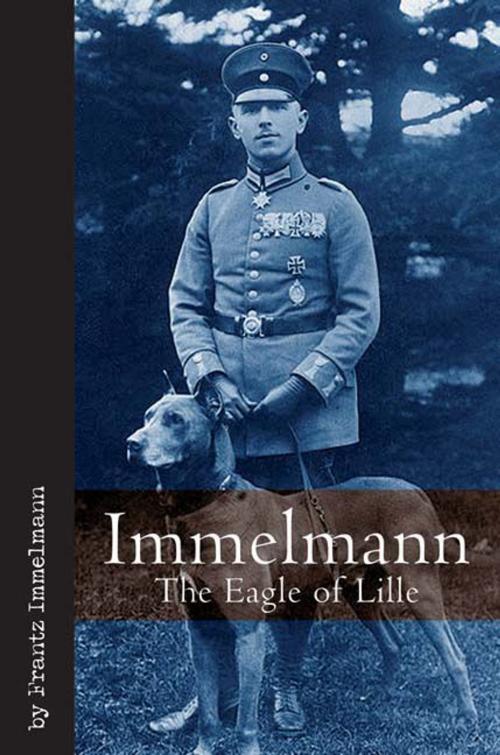| Author: | Frantz Immelmann | ISBN: | 9781935149767 |
| Publisher: | Casemate / Greenhill | Publication: | July 30, 2009 |
| Imprint: | Casemate / Greenhill | Language: | English |
| Author: | Frantz Immelmann |
| ISBN: | 9781935149767 |
| Publisher: | Casemate / Greenhill |
| Publication: | July 30, 2009 |
| Imprint: | Casemate / Greenhill |
| Language: | English |
The story of one of Germany’s pioneers in aerial combat . . .
Max Immelmann was born in Dresden, the son of a container factory owner. When World War I started, Immelmann was recalled to active service, transferred to the Luftstreitkäfte and was sent for pilot training in November 1914. He was initially stationed in northern France as a reconnaissance aviator. On June 3, 1915 he was shot down by a French pilot but managed to land safely behind German lines. He was decorated with the Iron Cross, Second Class for preserving his aircraft. Later in 1915, he became one of the first German fighter pilots, quickly building an impressive score of victories as he became known as The Eagle of Lille (Der Adler von Lille).
Immelmann was the first pilot to be awarded the Pour le Mérite, Germany’s highest military honor. The medal became colloquially known as the “Blue Max” in the German Air Service in honor of Immelmann. His medal was presented by Kaiser Wilhelm II in January 1916. Oswald Boelcke received his medal at the same ceremony.
Founder of the aerial combat maneuver that still bears his name, Immelmann was credited with 15 victories, his final one coming on 30 March 1916. He will forever be associated with the Fokker Eindecker, Germany’s first fighter aircraft, and the first to be armed with a machine gun synchronized to fire forward through the propeller arc. Along with Oswald Boelcke and other pilots, Immelmann was one of the main instigators of the Fokker Scourge which inflicted heavy loses upon British and French aircrews during 1915.
Originally published in 1930 by John Hamilton in London, the book has been reprinted (most recently in the 1990’s by Greenhill Books as part of it’s Vintage Aviation Library) and each time has been reproduced from the original 1930’s version of the book.
This new Casemate edition has been entirely reoriginated. Not a word has been changed, but the original (very dated) type and page layout have been reworked, as has been the format in which the book is presented, to give a beautiful new treatment to this classic of aviation literature.
The story of one of Germany’s pioneers in aerial combat . . .
Max Immelmann was born in Dresden, the son of a container factory owner. When World War I started, Immelmann was recalled to active service, transferred to the Luftstreitkäfte and was sent for pilot training in November 1914. He was initially stationed in northern France as a reconnaissance aviator. On June 3, 1915 he was shot down by a French pilot but managed to land safely behind German lines. He was decorated with the Iron Cross, Second Class for preserving his aircraft. Later in 1915, he became one of the first German fighter pilots, quickly building an impressive score of victories as he became known as The Eagle of Lille (Der Adler von Lille).
Immelmann was the first pilot to be awarded the Pour le Mérite, Germany’s highest military honor. The medal became colloquially known as the “Blue Max” in the German Air Service in honor of Immelmann. His medal was presented by Kaiser Wilhelm II in January 1916. Oswald Boelcke received his medal at the same ceremony.
Founder of the aerial combat maneuver that still bears his name, Immelmann was credited with 15 victories, his final one coming on 30 March 1916. He will forever be associated with the Fokker Eindecker, Germany’s first fighter aircraft, and the first to be armed with a machine gun synchronized to fire forward through the propeller arc. Along with Oswald Boelcke and other pilots, Immelmann was one of the main instigators of the Fokker Scourge which inflicted heavy loses upon British and French aircrews during 1915.
Originally published in 1930 by John Hamilton in London, the book has been reprinted (most recently in the 1990’s by Greenhill Books as part of it’s Vintage Aviation Library) and each time has been reproduced from the original 1930’s version of the book.
This new Casemate edition has been entirely reoriginated. Not a word has been changed, but the original (very dated) type and page layout have been reworked, as has been the format in which the book is presented, to give a beautiful new treatment to this classic of aviation literature.





![Cover of the book A Soldier’s Manuscript [Illustrated Edition] by Frantz Immelmann](https://www.kuoky.com/images/2014/august/300x300/9781782894810-I60d_300x.jpg)





![Cover of the book From Mons To Ypres With General French; A Personal Narrative [Illustrated Edition] by Frantz Immelmann](https://www.kuoky.com/images/2012/april/300x300/9781782890720-En6x_300x.jpg)



